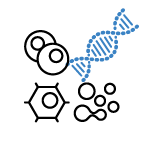Laboratory services
The offered service aims to determine the mechanism of cytotoxic action, which is of particular importance especially in research on new anticancer drugs.
Both apoptosis and necrosis may result from the action of cytotoxic compounds. Apoptosis is a harmonious and programmed mechanism for planned cell death that occurs in many physiological processes. Necrosis is a pathological and disorganized process that can cause severe inflammatory reactions. Therefore, drugs that eliminate unwanted cells by necrosis are less desirable from a clinical point of view. Therefore, at the stage of selecting new drug candidates, it is important to determine the occurrence and mechanism of their cytostatic action.
The analysis is performed in vivo on cells supplied by the client in suspension. The cell death mechanism is investigated by double staining with fluorescently labeled Annexin V (AnxV) and propidium iodide (PI). Annexin V binds specifically to phosphatidylserine on the surface of cells entering the apoptotic pathway. Additionally, propidium iodide allows to stain the DNA of cells whose membrane has been damaged, i.e. necrotic and late stages of apoptosis. The use of both dyes simultaneously allows to determine the number of cells undergoing cell death and to determine the proportion between its mechanisms. Thanks to this approach, it is possible to determine the cytotoxic potential of the tested substance and the mechanism of its action.
The analysis of distribution in the cell cycle is one of the basic tools used in the study of how this process functions and is controled. It also provides valuable information on the mechanism of action of potential new generation anti-cancer drugs which task is to inhibit proliferation by influencing the control mechanisms of the cell cycle. The use of flow cytometry allows you to quickly and reliably assess the distribution of the population at individual stages of the cycle.
LBBK offers a cytometric analysis service, which includes:
- Subjecting the suspension of fixed cells provided by the Customer to RNA removal treatment,
- Sample staining with propidium iodide (PI), a fluorescent dye that binds quantitatively to nucleic acids,
- Quantitative analysis of DNA in cells using flow cytometry,
- Determination of the number of cells remaining in particular phases of the cell cycle (G0 / G1, S, G2 / M), as well as atypical cells - apoptotic cells with a characteristic loss of DNA and polyploid cells.
The result of the analysis is information about the number and proportions between cells in particular phases of the cell cycle in the obtained cell population. The comparison of the obtained values between the given populations in different experimental variants may provide valuable information on the mechanism and place of cell freeze in the cycle.
Characteristics of multipotent stem cells may differ, for example, due to individual differences and to the place of collection of the material from which they are isolated. Determining the detailed characteristics of cells isolated from a given material, is necessary to determine their potential and justification for their use in a given application (e.g. therapeutic, for bone or cartilage regeneration, or as an immunomodulating factor). The result of the analysis can be used in many ways, including obtaining the optimal composition of the tested therapeutic for a given disease).
The service consists of detailed characterization of the isolated multipotent cells. As part of the service, the values of the following parameters will be determined:
- The number of living cells
- Recovery of living cells from a frozen sample
- Cell viability
- Cell morphology
- Markers of MSC cells according to ISCT (International Society for Cell Therapy)
- The level of expression of proteins characteristic for anti-inflammatory and immunomodulating properties (selected genes)
- The level of expression of proteins characteristic for the regeneration-promoting properties (selected genes)
- Determination in a in vitro culture of the potential of cells to differentiate bone tissue cells (osteogenic potential), adipose tissue cells (adipogenic potential) and cartilage cells (chondrogenic potential)
Optionally, it is also possible to isolate multipotent cells from the tissue.
We provide the measurement of total protein content service using the Pierce™ BCA Protein Assay Kit. A single service consists of measuring a maximum of 38 attempts, always in two technical repetitions. The general rule is to combine the well-known reduction of Cu2+ to Cu1+ by a protein in an alkaline environment with a very sensitive and selective colorimetric detection of the cuprous cation (Cu1+) with bicinchoninic acid (BCA). Absorbance measurement is performed on the Tecan Spark plate reader, while the results are made available in Excel format for your own analysis.
At our laboratory, we offer a service of measuring the viability of various types of cells. We have the best and well-proven reagents available on the market. We perform measurements for 47 samples, always in two technical repetitions for the tested sample. Thanks to the use of the PrestoBlue™ Cell Viability Reagent, which is easily metabolized by living cells, we can read it after 10 minutes of incubation. Fluorescence is measured with Tecan's advanced Spark plate reader and results are exported in Excel, which includes detailed reading information, from measurement time to exact fluorescence and sample position settings.
Technology of time-lapse microscopic observation, the so-called "Time-lapse" meets the need of real-time registration of biological processes taking place in cell cultures. We have a Nikon Eclipse Ti-E microscope, which is equipped with a modern environmental conditions control system (climate chamber with temperature, humidity and gas concentration control), thanks to which it provides stable conditions for sequential observations during long (several days) cell experiments. The automated system allows you to program observations in bright field, phase contrast and fluorescence in a multi-point system - on microscope slides or culture plates. The combination of these advanced technologies enables in vivo observation of fluorescently stained cells, as well as the processes of their adhesion and migration in the so-called scratch tests.
The offered service includes the preparation and conduct observations, along with the continuous operation and control of the culture and the microscope control program, collection and analysis of the obtained data in the form of photos or time-lapse videos. The service can be extended by establishing a cell culture intended for microscopic observation.
Depending on the client's needs and the type of experience, the following are agreed:
- breeding conditions in the climatic chamber (temperature, concentration of carbon dioxide and nitrogen),
- observation techniques - bright field, phase contrast, fluorescence (available filters: blue, red and green),
- magnification (available lenses: 4x, 10x, 20x, 40x),
- time intervals between consecutive photos,
- number of points observed.
Research services
We offer scientific research services according to the client's needs. We will help to design, plan and conduct research studies in the following scope:
- isolation of human and animal stem cells
- isolation of human and animal differentiated cells
- characteristics of cells
- cytotoxicity studies
- stem cell differentiation
- standard (2D) and scaffolding (3D) breeding
- research on biomaterials and biocompatibility
- studies of the influence of physical and chemical factors on the behavior of cells.






